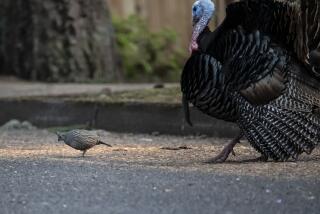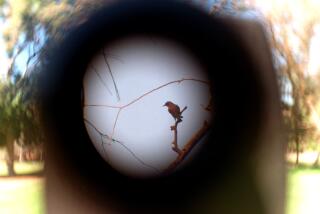Widow Assuages Grief With Love for Rare Bird
- Share via
MILTON, Vt. — From her tiny log cabin on a bluff overlooking a lake, the old lady warbles a love song as she rocks in her chair and peers through binoculars at the object of her affection.
High above, a lone bird soars, wings outstretched, in a blaze of brown and white.
To the untrained eye, the bird might be mistaken for a bald eagle, with its nearly 6-foot wingspan, fierce yellow eyes and distinctive white crest.
Until recently, it was almost as rare.
“Osprey, my osprey,” Meeri Zetterstrom coos, smiling at her own foolishness. “You didn’t know, I love you so.”
The bird traces long graceful circles in the sky, its wings flapping slowly in a distinctive M shape. It swoops low over a raggedy nest perched atop a man-made pole. The bird’s mate, a lighter chocolate brown, pokes her head out and begins a plaintive “cheerek
Another spring, another rhapsody of birdsong and blossoms bursting around Arrowhead Mountain Lake. Another remarkable return by the osprey to the nest that Meeri helped make their home.
Thirty years ago, these migratory fish-hunting birds were on the verge of extinction in Vermont and much of New England, their numbers devastated by the now-banned chemical DDT. The pesticide contaminated the food chain, poisoning the fish that osprey feed on and disrupting the females’ ability to produce calcium for strong eggshells. Flimsy shells were crushed instead of hatched. Nests were abandoned. And the mighty “fish-hawk,” whose dramatic 40-mile-an-hour plunge into the water was once a common sight along the lakes and shoreline marshes, became so rare that many states, including Vermont, declared the species endangered.
There seemed to be little hope for the osprey, other than perhaps a long and gradual recovery of a couple of nests.
This summer, in a turnaround that even state wildlife officials describe as almost miraculous, Vermont plans to remove the osprey from the endangered list.
Seventy-one nests were counted in the state last year, producing 84 chicks. For the first time in decades, the osprey are thriving.
And much of the credit goes to a small, energetic woman with a thick Finnish accent, a mop of gray curls, and a striking ability to charm and cajole. “Grandma Osprey,” she is called, and in her little corner of northeastern Vermont, Meeri Zetterstrom, 84, is considered as rare and extraordinary as the birds she protects.
Meeri feigns bashfulness when asked about her role.
“Sisu,” she says, the Finnish word for “stubborn.”
She never set out to become champion of the osprey, Meeri says, although sometimes when she rocks in her chair and reflects on her life, it seems to have been predestined. Growing up in Finland, she remembers seeing osprey -- thousands of them -- on lakes everywhere. “They were as common as robins,” she says.
Back then, she paid scant attention to the otherworldly beauty of their sky dance at dawn or the breathtaking athleticism of their dive for prey.
Back then, Meeri was more interested in seeing the world, in meeting the man of her dreams.
His name was Kurt Zetterstrom, and they met on a passenger ship in Sweden where he was an officer and Meeri worked as a waitress after she finished school. He resembled Britain’s Prince Philip. He made her feel like a princess.
They married and traveled the world working on an oil tanker, stopping for adventures at every port: camel rides beneath the Egyptian pyramids, motorcycling in Italy, picking pineapples in Africa. When they decided to settle down after 10 years of seafaring, they chose San Francisco.
But California proved too hot for their Scandinavian blood and Washington State, where they moved next, too rainy. Eventually, Meeri pulled out a map and plunked her finger down on a skinny strip of blue in New England. They packed up their Saab and drove to Vermont.
With their own hands, they built a two-bedroom cedar cabin on the shores of Arrowhead Mountain Lake, a 740-acre stretch of water built by a power company years earlier. Meeri tended their horses. Kurt worked as a draftsman.
Miles from the nearest town, they reveled in their solitude and their wild neighbors. The fox cub that crept into the kitchen to nibble cereal from Kurt’s spoon. The snapping turtles that crawled all the way into the barn. The fish -- northern pike and trout and perch. And, of course, the birds -- goldeneye, great blue heron, even a bald eagle.
But their favorite was a lone osprey that would perch on the dead old basswood tree outside their window. They would watch in awe as it circled the lake, hovering at great heights before plunging feet-first once it spotted its prey, hitting the water with a ferocious splash. Often it totally submerged before surfacing, talons sunk deep into a fish almost its size.
The osprey returned every year, although it didn’t seem to have a nest -- or a mate.
“It was such a mysterious thing,” Meeri says. “We didn’t know if it was male or female, but we loved that bird. We would look forward to seeing it every spring.”
Their lakeside idyll was shattered when Kurt died suddenly of a heart attack early in 1988. Lost without her husband, Meeri grew even more despondent when the osprey failed to return that spring. The bird didn’t appear the following year either.
Staring into the lake, Meeri made a silent vow.
“I cannot bring my husband back,” she thought, “but maybe I can bring back my osprey.”
She read everything she could about osprey and their nesting habits, about DDT’s effect, about efforts by some states to build platforms to encourage the birds to nest. Ospreys, she learned, usually mate for life, returning year after year to the same nest after wintering as far away as Guatemala.
The more Meeri read, the angrier she became. Even Benjamin Franklin had praised the purity and agility of the osprey over the “poor moral character” of the bald eagle, a scavenger who will sometimes steal an osprey’s catch. Yet there were only two known osprey nests in Vermont.
“People talked about protecting the loon, the peregrine falcon, the bald eagle, yet nothing for the osprey,” Meeri says. “The most beautiful bird of all.”
And so, as she tells it, “I started making noise.”
She called the state Fish and Wildlife Department so often that staff dubbed her “the osprey lady.” She harangued the power company that owns the land around the lake, demanding that it put up nesting platforms like those she had read about.
She went to stores and restaurants with a collection box, trying to raise money to build her own platform. She even went to a garden center and asked for a dead tree, the kind that ospreys like to built their nests in.
“They told me it would cost a thousand dollars,” she exclaims. “For a dead tree! I got so mad.”
By 1990, she had become so persistent that the power company, Central Vermont Public Service Corp., agreed to build two platforms, one atop the tree outside her cabin, the other above a 30-foot fiberglass pole on another part of the lake.
That Easter Sunday, Meeri watched, ecstatic, as a pair of osprey landed on the nest outside her cabin. The birds spent the summer fishing and building a bigger nest, although they didn’t breed. Not that Meeri worried. Young osprey often “play house” for a year or two before starting a family. “The honeymooners,” she called them.
Armed with dozens of photographs of the birds’ return, Meeri persuaded the power company to build more platforms. She helped a local citizens group successfully petition the Vermont Water Resources Board to ban jet skis on the lake and reduce the speed limit for motor boats.
In the next few years, more “honeymooners” arrived. But they continued to abandon their nests, driven away by boaters. Once, Meeri saw people actually shaking the nesting platform.
Furious, she videotaped the offenders, dispatching the tape to local television stations -- some aired it -- and to the state and power company officials.
“Meeri was relentless,” says Steve Costello, public relations director of the power company. “And she was right.”
Costello first encountered Meeri in 1996 on his first day on the job. A former newspaperman and amateur birder, he quickly came to respect her knowledge and devotion. He marveled at how she could watch the birds 12 to 14 hours a day. She knew far more about osprey than anything Costello had ever read.
Meeri took a liking to the dark-haired young man. They began working together and with the state to create an 800-foot buffer zone around the nests. They planted warning signs along the lake with pictures and information about the birds. They went into schools and talked about the endangered species.
And every spring, Meeri renewed her vigil, peering through her binoculars and praying for a miracle. In 1998, for the first time, the birds didn’t abandon the nest. In fact, the mother rarely left it. And Meeri rarely took her eyes off it.
And so she was a witness in mid-June when a little downy head popped up over the rim. Breathlessly she watched as the mother tore strips off a pike the father had just caught and, using her hooked bill, delicately placed them on the chick’s bright red tongue.
“I cried,” Meeri says. “I had never seen such a beautiful sight.” In her diary she wrote, “Today my first baby was born.”
Every year, the osprey have returned. And every year, Meeri welcomes them, noting in her logs the precise day and time they arrive. This year, the first pair were spotted at 4:10 p.m. on April 8. A second pair arrived a week later. Meeri believes that they are the offspring of the original nesters.
“This year,” she says proudly, “we will have three generations of osprey at Arrowhead Lake.”
Meeri has mixed feelings about the state’s plan to remove the osprey from the endangered list, a largely symbolic gesture, but one that will divert attention and funds to other birds, like the bald eagle. The recommendation, drafted by the state Fish and Wildlife Department, is expected to be signed by Natural Resources Secretary Elizabeth McLain later this year.
Meeri also has mixed feelings about her role, pointing out that the Arrowhead Mountain Lake birds are just a small part of a successful state restoration program that has also seen ospreys return to other parts of Vermont.
Still, in this part of the world, it is “Grandma Osprey” people think of when they see the majestic raptor. And it is Meeri they thank for bringing it back.
Meeri’s eyes are failing now and she doesn’t use the binoculars as much. They sit atop a pile of bird books in her cabin.
Also in the pile is a children’s book. Beautifully bound and illustrated, it tells of a young woman’s remarkable journey from Finland to Vermont, and a bird’s odyssey back to Arrowhead Mountain Lake.
The book was written by Costello and published in 2000, and copies were donated by the power company to every third-grader in the state. The idea, Costello says, was not just to teach them about endangered species, but to show them what one person could do.
The book is one of Meeri’s most prized possessions. It is titled “Meeri Meets the Osprey.”
More to Read
Sign up for Essential California
The most important California stories and recommendations in your inbox every morning.
You may occasionally receive promotional content from the Los Angeles Times.










